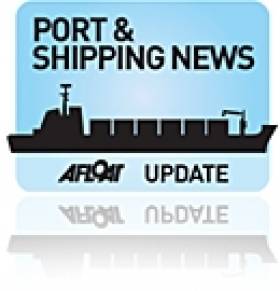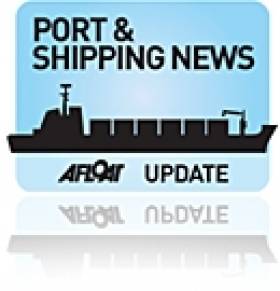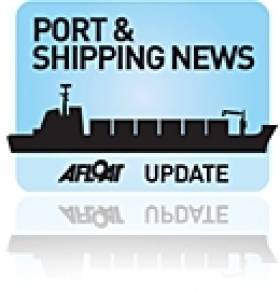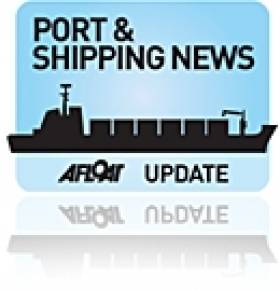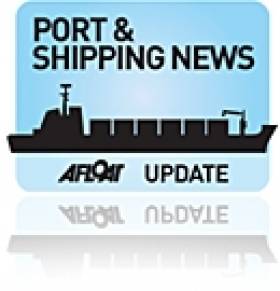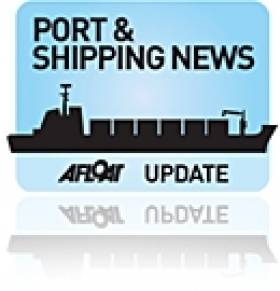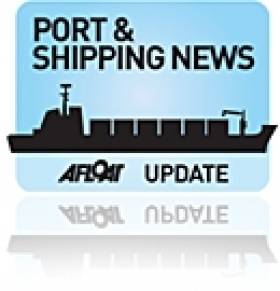Displaying items by tag: Arklow Shipping
Similar Named Ships Highlight 30th Anniversary Closure of Irish Shipping Ltd
#ArklowWillow- According to organisers of a Irish Shipping Ltd reunion this evening in Dublin, today marks the 30th anniversary of the liquidation of the former state-owned shipping company in 1984, writes Jehan Ashmore.
Following the outbreak of WWI in 1939, the Irish Goverment realised the perilous state of not having a strategic fleet under its control and so led to the formation of ISL which secured vessels to bring strategic vital food supplies to the shores of our dependent island.
As the decades passed a deep-sea global fleet developed. These Irish flagged ships were named from a theme based on tree species, for example Irish Willow. She was a general cargo ship of some 1,700 tonnes that served a career with the company from 1956 to 1969.
It is apt that an Irish cargoship currently has almost the same name, the Arklow Willow which is berthed in Dublin Port undergoing routine maintenance. In addition that the Arklow Shipping Ltd owned drybulk cargoship should be the only vessel from a 45-strong fleet to be named after a type of tree too!
At the time of ISL's collapse this day three decades ago on 14 November 1984, the state-company had only 7 vessels in service.
Arklow Willow is the final sister of a trio of 'W' class Japanese built vessels berthed in Dublin Graving Dock Ltd. At 14,001 dwt Arklow Willow is the largest in this class, though there are larger fleetmates also in terms of deadweight tonnes.
They are the South Korean newbuilds Arklow Spirit as previously reported (and newer sister Spray) at 34,919dwt and are also the largest Irish-flagged cargoships notably since the sad demise of ISL.
Arklow Willow had recently arrived from Corunna, north-west Spain and the 136m long vessel occupies the 200m long Graving Dock No.2. This differs to last month's double dry-docking as previously reported of the smaller Arklow Ranger and Jeanie Johnston, which shared the dry-dock located in Alexandra Basin.
Dublin Port Company have submitted plans to re-develop the basin costing €200m which would form phase one of the port's Masterplan 2040. The project would involve the re-use of the site of the drydock which as a result would face closure.
Irish-Dutch Cargoship Dry Docks In Dublin
#DublinDryDocks - Dublin Graving Docks Ltd which as previously reported on Afloat.ie faces closure by Dublin Port Co. over plans to redevelop Alexandra Basin that incorporates the site of the 200m long graving dock is currently occupied by a pair of vessels, writes Jehan Ashmore.
The dry docked vessels at the ship-repairer and conversion business are the Dutch built Arklow Raider (2002/2,999grt) one of Arklow Shipping's general cargoships flagged in the Netherlands and the museum tallship Jeanie Johnston.
Up to 26 people are employed at the facility which has seen an increase in clients compared to last year. The dockyard primarily caters for trawlers and larger dry-cargo vessels than that of Arklow Raider, among them the 8,900 tonnes 'W' class and 9,700 tonnes 'M' class series from the Irish flagged fleet of Arklow Shipping Ltd.
One of the 'M' class vessels, Arklow Mill which was featured on Afloat.ie during a call to the Shannon at Aughinish Alumina plant, had work carried out by Dublin Graving Dock in 2013. This was to increase the deadweight tonnage (dwt) up to 14,990 tonnes, making her one of the largest in the fleet until the more recent introduction of 'S' class sisters each of 34,905dwt.
The Dutch division of ASL operate a smaller fleet of vessels registered in Rotterdam from where Arklow Shipping Netherlands are based.
When either of the W and M class vessels are booked into the dry-dock due to their overall dimensions they take up the entire graving dock. The graving dock can accommodate ships drawing a maximum draft of 6.5m and having a beam of up to 24.5m.
In the current circumstance of two vessels within Graving Dock No. 2, a dockgate (caisson) divides the ships apart into separate chambers. This will allow the Dutch built Arklow Raider to vacate first as her work is scheduled to be completed prior to that of Jeanie Johnston.
The chamber where Arklow Raider occcupies will be flooded and without interrupting the Jeanie Johnston. Work on the barque is not expected to be completed until later this month. Her opening date as a museum ship has been advertised as 1 November.
Beacon of Green Light Shines As Arklow Newbuild Launched
#ArklowGreenNewbuild- This afternoon Arklow Shipping's fourth out of a total of six 4,800dwt newbuilds, Arklow Beacon was launched from a Dutch shipyard, writes Jehan Ashmore.
She features a 'green' credential designed hull form which was given a 'sideways' launch. No doubt a proud moment for ASL officials, dignitaries and yard workers alike attending the ceremony at the Ferus Smit yard at Westerbroek.
The German shipbuilding firm's Dutch yard was contracted by ASL to build the series of the 119m long multi-purpose bulk orientated general cargoships. The class have a hull form that was chosen to adapt the 'bulbless' principle; creating a slender bow without bulb.
Her design also takes into account various loading drafts and wave conditions to be encountered in service. The performance of this bow will be better suited than a bulb optimised for one single draft operations and when on flat water only.
Arklow Beacon is to join the Irish company's Dutch subsidiary in October under the management of Arklow Shipping Netherlands B.V. based in the Rotterdam. Likewise of her sisters, in which Arklow Beach was the last to be completed in June, flies the flag of the Netherlands.
Classed under Bureau Veritas, the newbuilds have a two-hold grain capacity of 9902,6m³ and for bale of 349.706ft³.
She will mainly be employed in the shipment of wheat, corn and other bulk commodities in European waters. A speed of 13 knots will be delivered from a Mak engine.
Arklow's 'Green' Beacon to Be Launched This Month
#ArklowGreens- Arklow Shipping's fourth of six 4,800dwt newbuilds, Arklow Beacon featuring a 'green' credential designed hull is to be launched later this month in the Netherlands, writes Jehan Ashmore.
The 119m multi-purpose bulk orientated general cargoship like her sisters are built by Ferus Smit's Dutch yard at Westerbroek. Leadship Arklow Bank was launched earlier this year, she was followed by sisters also taking 'B' names, Arklow Bay and the latest to date in the series Arklow Beach which appeared in June.
The class have a hull form that was chosen to adapt the 'bulbless' principle creating a slender bow that dispenses the bulb. Taking into account the various loading drafts and wave conditions to be encountered in service, the total performance of this bow will be better than a bulb optimised for one single draft and flat water only.
Arklow Beacon will join the Irish company's Dutch subsidiary, Arklow Shipping Netherlands B.V. based in the Rotterdam.
The newbuilds classed with Bureau Veritas have a two-hold grain capacity of 9902,6m³ and for bale of 349.706ft³ . They will mainly be employed in the shipment of wheat, corn and other bulk commodities in European waters. Powerplant is a Mak engine delivering a maximum 13 knots.
Arklow’s Newest & Greenest Newbuilds Dock in Irish Ports
#ArklowGreens - Arklow Bank, leadship of six 'B' class newbuild general cargoships (4,800dwt) of the Arklow Shipping fleet is berthed at the Boliden Jetty mineral terminal in Dublin Port, writes Jehan Ashmore.
The newbuild has 'greener' hull design credentials and along with her sisters flies the Dutch flag for Arklow Shipping Netherland B.V. As previously reported, her launch earlier this year was from Ferus Smit's Dutch shipyard at Westerbroek.
The B class dispense the use of a bulbous bow and instead is replaced with a straight-stem bow shape which brings a number of 'environmental' advantages. This allows the 119m hulled newbuilds which have sharper waterlines to have reduced resistance irrespective of loading draft.
Earlier this week Arklow Bank arrived from Coruna, northern Spain to the 'Coal' berth where scrap-metal is one of the trading activities that occupy this quayside. In recent days she shifted to load at Boliden (formerly Tara Mines) zinc loading terminal in Alexandra Basin and is expected to depart today.
Another sister, Arklow Bay which was launched in March (following Arklow Beach) became the largest ever vessel to trade to Drogheda Port last month. She too arrived from a Spanish port, Garrucha carrying a cargo of gypsum for Irish Cement's Platin plant facility.
#GreenNewbuild – Arklow Beach became the third of six 'B' class 'green' newbuilds launched amidships at the Ferus Smit yard in Westerbroek, the Netherlands for Arklow Shipping's Dutch subsidiary, writes Jehan Ashmore.
The spectacular sideways launch (see photo's) and christening of the 4,800dwt vessel yard No. 111 follows Arklow Bay in March and class leadship Arklow Bank in January. Next month this latest unit of the 119m long newbuilds will be delivered to Arklow Shipping Netherland based in Rotterdam, which will also be her port of registry.
The new series of bulk oriented general cargo ships have 'greener' credentials in that her slender straight-stem hull form coupled by a 'bulb-less' reduces wave resistance.
The design also takes into account the various loading drafts and wave conditions to be encountered in service. In addition the performance of the bow design will be better than an alternative bulb for single-draft and flat-water only transits.
Arklow Beach alongside her sisters will be mainly employed in the shipment of wheat, corn and other bulk commodities within European waters.
Irish Cargoship Re-floated at Mouth of Drogheda Port
#ArklowRuler – As previously reported, Arklow Ruler (2006/2,999grt), which ran aground at the entrance of Drogheda Port at the mouth of the Boyne, was eventually re-floated late this morning, writes Jehan Ashmore.
A previous attempt to re-float the Irish-flagged 80m vessel off the Co. Louth port's northern breakwater at high-tide had proved unsuccessful.
At the same time of this morning's departure of Arklow Ruler bound for Antwerp, the port re-opened for business as the pilot launch cutter, Boyne Protector attended another cargoship.
The incident follows a similar grounding in 2010 by a younger sister, Arklow Raider in which the MCIB investigated into the vessel which went onto a sandbank in the same vicinity.
Arklow’s Newest and Largest Bulk-Carrier Heads for Antwerp
#ArklowNewBULKER – Arklow Shipping Ltd's newest and largest bulk-carrier Arklow Spray is currently heading along the Western Scheldt leading to Antwerp, having departed Liverpool's Gladstone Dock lock mid-week, writes Jehan Ashmore.
Arklow Spray which was berthed at Liverpool's Royal Seaforth Container Terminal (See Liverpool2) , was delivered this year to ASL having been launched last year from South Korean shipbuilders.
The 34,919dwt ship principle dimensions are length: 182m, beam 30m on a draft of 10m. She has a grain capacity of almost 47,000m3 and engine output delivers 14 knots.
She is the second of the 'S' class following Arklow Spirit which was launched last year also from the same Asian shipyard of Daesun Shipbuilding & Engineering.
Departing Liverpool this morning, another Arklow bulk-carrier, the 2004 built Arklow Wind, one of the 'W' class bulk-carriers, had shared the Gladstone Dock lock with P&O Ferries Norbank, one of three ro-pax ferries serving the Dublin route.
As for the Arklow Wind she is bound for the jetty at Aughinish Alumina on the Shannon Estuary.
Across the Irish Sea in Dublin Port are even more Arklow vessels, the 2009 built bulk-carrier Arklow Manor which is berthed at Alexandra Basin West and also nearby the smaller short-sea general cargoship Arklow Future.
All three bulk-carriers represent a succession of vessel designs and ships that entered service just over a decade ago and all are Irish flagged and registered in their owner's homeport of Arklow.
Arklow Shipping have a healthy track history of constantly replacing older tonnage with newbuilds.
As previously reported six 'B' class 'greener' multi-purpose general cargo-ships are on order from Ferus Smit shipyard's Dutch facility in Westerbroek which launched Arklow Bay last month.
Unlike her bulk-carrier counterparts, she is part of ASL's Dutch division, Arklow Shipping Netherland based in Rotterdam, the port of registry of her sister leadship Arklow Bank.
Second Arklow 'Green' Newbuild Launched at Dutch Shipyard
#GreenNewbuild - Arklow Bay was launched by a Dutch shipyard on Friday, she is the second newbuild of six 'B'class 4,800dwt multi-purpose cargoships on order to Arklow Shipping Ltd, writes Jehan Ashmore.
The amidships or sideways launch of the vessel was carried out at Ferus Smit's second shipyard outside, Germany, at Westerbroek in the Netherlands. The 119m long leadship follows leadship Arklow Bank which was launched in January.
Next month the newbuild is due to be delivered to ASL's Dutch division Arklow Shipping N.V. based in Rotterdam from where she will be registered.
She has a slender hull form to optimise her 'green' credentials and a 'bulb-less' principle, where Arklow Bay will give better performance while not compromising on load capacity.
The design is a bulk oriented general cargo ship that will be mainly employed in the shipment of wheat, corn and other bulk commodities in European waters.
Arklow Shipping Newbuilds from Dutch and South Korean Shipyards
#ArklowNewbuilds - Arklow Shipping's latest newbuilds are a general cargoship and bulk-carrier completed from Dutch and South Korean shipyards respectively and together they raise the fleet total to some 44 vessels, writes Jehan Ashmore.
Arklow Bank is understood to be the first of six 'B' class general cargoships ordered by ASL and was completed by Ferus Smit B.V. of Westerbroek in the Netherlands.
Notably, her design differs compared to her older counterparts in that she has a larger tonnage of 5,065 tonnes, an additional superstructure deck and hull design particularly the 'straight' stemmed and bulb-less bow.
This new hull form will give these new 'B' class vessels greater 'green' advantages as the longer and sharper waterlines reduce wave resistance even in rougher conditions, thus lessening impact irrespective of loading draft as deadweight of 4,800 tonnes allows to maximise cargo volume. The 119m long ship which is classed with Bureau Veritas has a two-hold grain capacity of 9902,6m³ and for bale of 349.706ft³ . Powerplant is a Mak engine delivering a maximum 13 knots.
She will join the company's Dutch division, Arklow Shipping Nederland B.V. based in Rotterdam, from where the newbuild takes that port of registry. This Dutch fleet forms a minority within the overall fleet that flies the Irish tricolour and registered aptly in the homeport and headquarters of the company located on the banks of the River Avoca.
Adding to the Arklow based fleet is the second newbuild, Arklow Spray which is a 'S' class 34,500 dwt tonnes bulk-carrier completed by Daesun Shipbuilding & Engineering of South Korea. Likewise this newbuild is also classed under Bureau Veritas.
Principle dimensions of the 22,868 gross tonnage Arklow Spray are length 182m, beam 30m and a draft of 10m. She easily surpasses both the companies 'W' and 'M' class of bulkers (see Arklow Mill as previously reported) in terms of overall dimensions.
Arklow Spray is the second of this new design following lead ship, Arklow Spirit which entered service last year. The pair each has five holds handling a grain capacity of almost 47,000m³ and for bale just shy of 45,000m³. Cargo-handling is served by 4 x 30t MacGregor Electric cranes. A main MAN engine plant delivers a maximum speed of about 14 knots based on a cargo-laden capacity.
The newbuild sisters continue to inherent the 'S' class vessel naming theme of a previous generation of much smaller Dutch built bulkers. Arklow Spirit became the last member of these ships to be sold off in recent years.



























